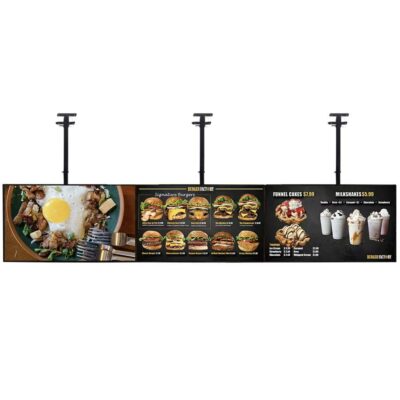Introduction
Restaurants, cafés, and food service businesses have long relied on printed menu boards to guide customer decisions. But with technology advancing rapidly, digital menu boards are now transforming how brands present their offerings. To make informed purchasing decisions, businesses must carefully weigh the pros and cons of both digital and traditional displays.
📌 Traditional Menu Displays: Pros and Cons
Advantages:
Low Initial Cost – Printing static boards is often less expensive upfront.
Simplicity – Easy to produce and install with minimal technical requirements.
No Power Needed – Traditional signs require no electricity or maintenance.
Drawbacks:
Limited Flexibility – Any change in pricing or items requires costly reprints.
Outdated Appearance – Static boards lack the dynamic appeal customers now expect.
Inconsistent Branding – Multiple locations may struggle to maintain design consistency.
📺 Digital Menu Boards: Key Benefits
Compared with static displays, digital menu boards offer unmatched adaptability:
Real-Time Updates – Instantly modify pricing, promotions, or product availability.
Dynamic Content – Use videos, animations, and rotating visuals to boost engagement.
Operational Efficiency – Centralized control ensures updates across all locations simultaneously.
Upselling Power – Highlight combo deals or premium products to influence purchase decisions.
Professional Appearance – Sleek displays align with modern customer expectations.
By sourcing from trusted Digital Menu Boards Suppliers, restaurants gain access to reliable systems designed for high-volume food service operations.
⚖️ Cost and ROI Considerations
While digital boards require higher initial investment, they pay off in the long term by reducing reprint costs, enabling targeted marketing, and generating higher sales. Traditional boards may suit small, independent cafés, but for chain restaurants or franchises, digital signage is often the more profitable choice.
🍴 Industry Applications
Quick Service Restaurants (QSRs): Digital menus speed up service and reduce errors.
Cafés: Highlight seasonal drinks and limited-time offers with dynamic visuals.
Food Courts: Digital boards unify brand presentation across multiple vendors.
Fine Dining: Interactive boards present wine pairings and chef specials.
Wholesale procurement from Digital Signage Wholesale helps larger businesses standardize installations across multiple outlets while keeping costs manageable.
🚀 Customer Experience Impact
Clarity: Digital menus present items more clearly, reducing confusion.
Engagement: Moving visuals capture attention better than static boards.
Adaptability: Instant updates match evolving customer trends.
Professionalism: Modern displays strengthen brand credibility.
Conclusion
When comparing digital menu boards to traditional menu displays, it becomes clear that digital solutions provide greater flexibility, branding consistency, and ROI. While printed boards may remain practical for some small operators, most modern restaurants benefit significantly from digital signage powered by reliable suppliers and wholesale solutions.
















